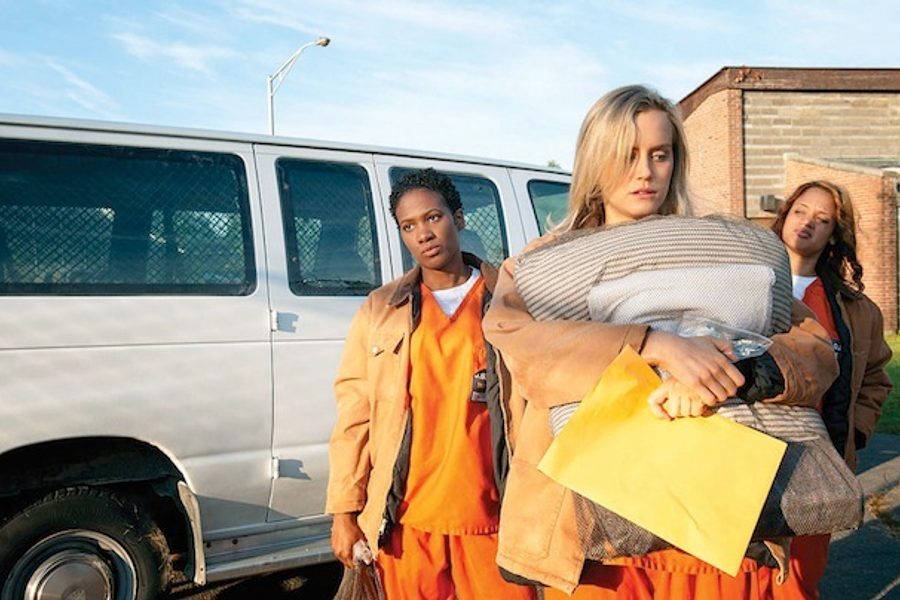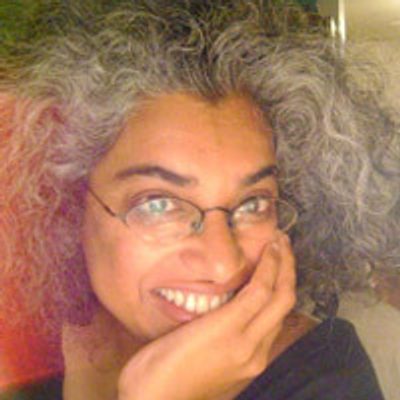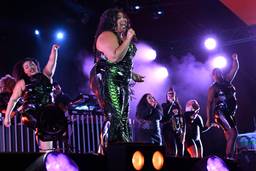White Chick Behind Bars
Netflix’s Orange is the New Black gets an ‘A’ on queer issues, a ‘C’ on race and an ‘F’ on class.
Yasmin Nair

[Warning: This piece contains minor plot spoilers from the series.]
The strange positioning of a bra in an explicit lesbian sex scene reveals volumes about the erotic economy of Netflix’s latest series, Orange is the New Black, about women in prison.
Two white women, Nicky Nichols (played by Natasha Lyonne) and Lorna Morello (Yael Stone), are fucking vigorously in a prison chapel. They’ve been at it for a while when the camera cuts to a shot of Morello’s upper body. Despite all the thrashing around, she manages to hide her breasts with, first, her hands, and then her bra, which stays mysteriously well-positioned. There’s barely a nipple in sight as she pulls herself together. It’s as if the invisible hands of Christ had reached down and carefully held up the straps.
Both Morello and Nichols are minorities in the prison, which is realistic — the majority of prisoners in the United States are people of color. But while white female prisoners may be in the minority, Orange is clear about their placement in the hierarchy of voyeurism. White women’s nakedness is almost always artfully covered. When the lead character, Piper Chapman, also white, first emerges from the prison shower, she’s told that she has perky “TV titties,” though we see only a quick glimpse of them before she covers them up. In Orange’s world, white women walk around wrapped in giant towels, while throughout the show, numerous naked women of color — though inevitably only those possessed of “TV-titties” — are posed like models, breasts firmly if unnaturally thrust forward.
The problem here isn’t that women of color are shown naked. It’s that their bodies are starkly eroticized where white women’s are concealed in order to preserve their putative modesty. It’s a strange move for a show that otherwise revels in sex between women, but that’s the confusion of the show’s worldview. While Orange does relatively well with queerness and is careful to showcase racial diversity, it fails in its use of stock narratives about race and, to an even more devastating extent, class.
Based on Piper Kerman’s memoir of the same name, Orange documents the experiences of a Connecticut WASP named Piper Chapman who’s in prison because she transported money for the head of a drug cartel, who happened to be her lesbian lover. The show creates a complex array of characters both inside and outside the prison, people whose sexuality slides merrily up and down the Kinsey scale, and whom it renders with affection and warmth.
Chapman’s backstory, told in flashbacks, could well have been subtitled, “A Horribly Long Series of Giant Fuck-Ups.” A graduate of Smith, she wanders from job to job until she meets up with drug-dealing, globe-trotting Alex Vause (Laura Prepon) and gleefully falls for both the woman and the luxurious and adventurous lifestyle she offers.
Chapman’s subsequent return to polite society is brought to a crashing halt when, just as she’s about to tie the knot with her boyfriend, Larry Bloom (Jason Biggs), she’s indicted on drug-smuggling charges ten years after the fact. As she puts it, with slight irony, her dream was to just be a “nice blonde lady” and lead an uncomplicated life.
Orange doesn’t evade the complexity of Chapman’s queerness or suggest that her lesbianism is simply a phase or experimentation, and it repeatedly points out that sexuality is fluid, often humorously. When her best friend wonders aloud if she might “turn gay” because Chapman’s ex is also in jail with her, she retorts exasperatedly, “You don’t just turn gay, you fall somewhere on a spectrum, like on the Kinsey scale.” The sex scenes, too, are played with a degree of humor and zest that ensure they aren’t just voyeurism for straight viewers.
So, in terms of queerness, we’re all good: Orange doesn’t offend on that score, and will doubtless get high marks from GLAAD for its “positive portrayal.”
But while viewers are treated to a wittily rendered primer on the complexity of queerness, they’re presented with stock characterizations of people of color, and of poor people of all races.
White women and women of color in the prison get not only different kinds of nudity, but different kinds of agency. Chapman may be the deluded and confused white chick in the midst of women who are mostly of color and from much scrappier backgrounds, but she’s also portrayed as the only one who can rise above her own needs to consider the larger issues facing inmates. In one scene, Chapman and a few other inmates are in the warden’s office, after being elected to an advisory council. Only she, the sole white woman, raises the most pressing issues, like the discontinuation of GED classes and the closing of a running track. In contrast, the others are silenced by the threat of not getting doughnuts and coffee at these meetings. Their most pressing demand is Sriracha.
This goes against what we know about prison movements, which have often been and continue to be led by women and people of color, many of them queer and trans people. Angela Davis, who spent time in prison, is one of the world’s foremost abolitionists, as is Miss Major Griffin-Gracy, a formerly incarcerated trans prison activist with roots in Stonewall (and the subject of a forthcoming documentary). Yet, from the perspective of the show, only white women have the wherewithal to understand and contest prison conditions.
Which leads us to one of the show’s underlying problems: Orange ultimately sees prison as the logical, if slightly flawed, corrective to society’s problems. Rather than recognizing the prison as the Prison Industrial Complex and questioning a system that keeps recirculating people (mostly of color) through its doors in order to survive, the show sees prisons as housing units, almost like sorority houses. The rationale here is that prison can be a fun place, if only some of the worst elements, like solitary confinement or bad food, were taken away.
The show’s inability to examine the structural factors that determine who ends up behind bars, and what happens to them when they get out, is seen clearly in Chapman’s insistence that going to prison is a matter of “choices.” At one point, Chapman talks about how prison supposedly forces you to come face to face with who you really are: “I’m scared that I’m not myself in here, and that I’m scared that I am.” To Chapman, what you did – the “choice” that landed you in prison — can be plumbed to reveal your essential moral fiber, some basic truth of selfhood. When Chapman’s WASP-y mother visits, she bemoans the fact that her daughter is in prison with people who are “nothing like you,” leading Chapman to explode into a fiery speech about how she’s exactly like everyone else: “I’m in here because I made bad choices. I’m no different than anyone else.”
This moment, which is included in the show’s trailer, is apparently intended as a revelation.
And yet it’s simply not true. The reality for most people in prison, who are also mostly people of color, is that you’re in jail for who you are — not in Chapman’s moralistic sense, but in stark racial terms. For instance, studies indicate that Black people are four times more likely to be arrested for the possession of marijuana than whites, and that people of color face harsher sentences than whites for comparable crimes. More recent analysis of the failed “drug wars” indicates that they’ve done nothing to eradicate issues of poverty and violence in underserved neighborhoods, but instead created economies of need where drug peddling becomes an economic necessity.
Moreover, the show can’t conceive of the fact that the biggest hurdle for most of the women in prison with Chapman is not that they made “bad choices,” but that their future choices are foreclosed by prison. Chapman and white women like her can eventually get beyond their arrest records. The very existence of the show and the success of the book on which it’s based testify to the fact that for a white woman, a “bad choice” can become a second chance. It’s unlikely that a Black woman in the same situation as Kerman could simply walk out after her sentence and turn her experience into a best-selling book and television series.
When the show does deal with the question of what happens to women of color when they get out of prison, it dodges the insurmountable obstacles standing in their way. For instance, when a young Black woman, “Taystee” Jefferson (Daniele Brooks) finally ends her prison term, she leaves with a joyous farewell party thrown for her. But then she’s back a couple of episodes later and explains, in one of the most heartbreaking scenes, the difficulties of the outside: Constant surveillance by the state, the impossibility of finding jobs, her lack of a support system outside. At least inside, she says, she has a bed, a routine, and friends.
On the one hand, the scene could potentially serve to highlight the differences between Chapman and Jefferson. The problem is that there are no structural reasons provided for the latter’s situation outside, only that she has no friends; even her inability to find a job isn’t really portrayed as a structural problem. Her return to prison is depicted as a voluntary one, and emerges almost as one bound to her DNA, just as Chapman’s ability to think about others is also bound to her whiteness, an instinctual need to care for others.
Despite its many wrong notes with regard to race and ethnicity, it’s clear that Orange makes a conscious effort to only be “positive” towards racial, ethnic, and sexual minorities — even its sole trans character, Sophia Burset (Laverne Cox) is drawn sympathetically.
But every show needs a villain, someone who can be completely cast out of its moral universe. A show bent on positive portrayals of people of color and queers must then look elsewhere for its true villain.
Enter Tiffany Doggett, (Taryn Manning), also called Pennsatuky — a mash-up of “Pennsylvania” and “Kentucky” — the prison’s resident “white trash” born-again Christian who’s also, tellingly, the only white woman whose naked body is turned fully to the camera’s gaze.
At the beginning of the flashback that recounts Doggett’s story, we see her in bed with a lover, smoking post-coitus, casually talking about drugs and an upcoming abortion. Doggett’s jagged, broken teeth and her thin, naked body testify to the generational poverty of her kind. Hers is not the more readily understood poverty that’s now discussed in public discourse, the poverty of the recently poor, the sort that the Occupy movement fights for, of those still shocked at their expulsion by capitalism. Rather, it’s a poverty born and bred in the bone, impossible to escape.
There is no sympathy towards Doggett in the show, who’s portrayed as the worst of the worst: Homophobic, racist, and filled with a zealotry and belief in an angry and vengeful god.
Conflict ensues between Chapman and Doggett, who’s conceived of as her natural enemy within the show’s moral universe. There’s a long and continuing tradition in both cinema and television of lower-class whites being mocked and demonized to the fullest extent. We have no way to explain or address a world of relentless poverty that also breeds hatred towards every other kind of minority, and our best choice is to render the people in it as arch villains, beyond hope and redemption. So, when Chapman comes into conflict with Doggett, she and the show punish a figure who lives in the forgotten economic underbelly of the American Dream.
Orange engages in a classic form of feel-good diversity — it’s good on queers, relatively good on people of color, and, since the poor remain invisible, no particular identifiable group is likely to issue angry letters of complaint about misrepresentation. Orange makes prison seem like a nightmare inflicted only upon those who actively seek it out by doing things against the law, but doesn’t question the structural inequality which affects queers, women of color, and very poor and powerless people differently, and which places them in prison. White women like Kerman leave prison with book contracts, while others keep moving through its doors, fodder for the expanding Prison Industrial Complex.
Yasmin Nair is a writer, academic, and activist. She’s an editor at large at Current Affairs, on the editorial board of the Anarchist Review of Books, co-founder of the radical queer editorial collective Against Equality and the (Volunteer) Policy Director of Gender JUST. She’s currently working on her book Strange Love: A History of Social Justice And Why It Needs To Die. Her writing can be found at www.yasminnair.com.








